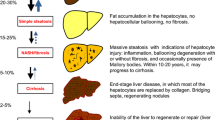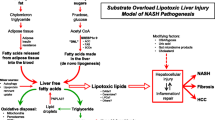Abstract
The global diffusion of the so-called Western diet, which is enriched in fat and carbohydrates, such as fructose, has been proposed to be an underlying cause of the increased prevalence of metabolic conditions, including non-alcoholic fatty liver disease (NAFLD). This Smart Card summarizes the main metabolic and hepatic histological features of rodent models fed with diets combining high fat and fructose.
Similar content being viewed by others
Introduction
Non-alcoholic fatty liver disease (NAFLD), a condition regarded as the hepatic manifestation of the metabolic syndrome, currently represents the most common cause of chronic liver disease [1]. The condition ranges from simple hepatic fat accumulation (steatosis) to non-alcoholic steatohepatitis, where fat is accompanied by hepatocyte injury, and necroinflammation. This condition poses an increased risk of cirrhosis and hepatocellular carcinoma [1]. The dramatic increase in prevalence of obesity, metabolic syndrome, and NAFLD has been linked to the global diffusion of the Western diet, characterized by excess caloric intake due to increased consumption of processed food and beverages, coupled with a more sedentary lifestyle [2, 3]. This has led to a significant increase in sucrose and high-fructose corn syrup consumption, both of which contain similar amounts of glucose and fructose [4]. In the USA, for example, fructose consumption has more than doubled in the last three decades [3]. Excessive fructose consumption has been linked to an increased prevalence of metabolic diseases and growing evidence suggests that it may also contribute to the development and severity of NAFLD by exacerbating fat deposition, inflammation, and, possibly fibrosis [5]. Mechanistically, fructose may contribute to NAFLD by promoting de-novo lipogenesis, insulin resistance, oxidative stress, bacterial overgrowth, and inflammation [3–7]. The mechanisms responsible for transition to non-alcoholic steatohepatitis are still not completely understood, in part because of the scarcity of animal models that can fully replicate both the histological and metabolic features of human non-alcoholic steatohepatitis [8]. As fructose is likely to act as a dietary ‘second hit’ [5], effort has recently been put into developing novel experimental models to recapitulate the Western diet by combining high-fat or high-energy diets and fructose. The aim of this Smart Card is to provide a synthetic and exhaustive source for rapid consultation of the currently proposed rodent models of diets combining high fat and fructose, summarizing the metabolic and hepatic consequences of such combinations (Table 1).
Abbreviations
- GTT-AUC:
-
Glucose tolerance test: area under the curve
- HOMA-IR:
-
Homeostasis model of assessment - insulin resistance
- NAFLD:
-
Non-alcoholic fatty liver disease
- w/v:
-
Weight by volume.
References
Chalasani N, Younossi Z, Lavine JE, Diehl AM, Brunt EM, Cusi K, Charlton M, Sanyal AJ: The diagnosis and management of non-alcoholic fatty liver disease: practice guideline by the American Gastroenterological Association, American Association for the Study of Liver Diseases, and American College of Gastroenterology. Gastroenterology. 2012, 142: 1592-1609. 10.1053/j.gastro.2012.04.001.
Anania FA: Non-alcoholic fatty liver disease and fructose: bad for us, better for mice. J Hepatol. 2011, 55: 218-220. 10.1016/j.jhep.2011.01.029.
Lim JS, Mietus-Snyder M, Valente A, Schwarz JM, Lustig RH: The role of fructose in the pathogenesis of NAFLD and the metabolic syndrome. Nat Rev Gastroenterol Hepatol. 2010, 7: 251-264. 10.1038/nrgastro.2010.41.
Samuel VT: Fructose induced lipogenesis: from sugar to fat to insulin resistance. Trends Endocrinol Metab. 2011, 22: 60-65. 10.1016/j.tem.2010.10.003.
Vos MB, Lavine JE: Dietary fructose in nonalcoholic fatty liver disease. Hepatology. 2013, 57: 2525-2531. 10.1002/hep.26299.
Nomura K, Yamanouchi T: The role of fructose-enriched diets in mechanisms of nonalcoholic fatty liver disease. J Nutr Biochem. 2012, 23: 203-208. 10.1016/j.jnutbio.2011.09.006.
Yilmaz Y: Review article: fructose in non-alcoholic fatty liver disease. Aliment Pharmacol Ther. 2012, 35: 1135-1144. 10.1111/j.1365-2036.2012.05080.x.
Charlton M, Krishnan A, Viker K, Sanderson S, Cazanave S, McConico A, Masuoko H, Gores G: Fast food diet mouse: novel small animal model of NASH with ballooning, progressive fibrosis, and high physiological fidelity to the human condition. Am J Physiol Gastrointest Liver Physiol. 2011, 301: G825-G834. 10.1152/ajpgi.00145.2011.
Tetri LH, Basaranoglu M, Brunt EM, Yerian LM, Neuschwander-Tetri BA: Severe NAFLD with hepatic necroinflammatory changes in mice fed trans fats and a high-fructose corn syrup equivalent. Am J Physiol Gastrointest Liver Physiol. 2008, 295: G987-G995. 10.1152/ajpgi.90272.2008.
Kohli R, Kirby M, Xanthakos SA, Softic S, Feldstein AE, Saxena V, Tang PH, Miles L, Miles MV, Balistreri WF, Woods SC, Seeley RJ: High-fructose, medium chain trans fat diet induces liver fibrosis and elevates plasma coenzyme Q9 in a novel murine model of obesity and nonalcoholic steatohepatitis. Hepatology. 2010, 52: 934-944. 10.1002/hep.23797.
Wada T, Kenmochi H, Miyashita Y, Sasaki M, Ojima M, Sasahara M, Koya D, Tsuneki H, Sasaoka T: Spironolactone improves glucose and lipid metabolism by ameliorating hepatic steatosis and inflammation and suppressing enhanced gluconeogenesis induced by high-fat and high-fructose diet. Endocrinology. 2010, 151: 2040-2049. 10.1210/en.2009-0869.
Feillet-Coudray C, Sutra T, Fouret G, Ramos J, Wrutniak-Cabello C, Cabello G, Cristol JP, Coudray C: Oxidative stress in rats fed a high-fat high-sucrose diet and preventive effect of polyphenols: Involvement of mitochondrial and NAD(P)H oxidase systems. Free Radic Biol Med. 2009, 46: 624-632. 10.1016/j.freeradbiomed.2008.11.020.
Sohet FM, Neyrinck AM, Pachikian BD, de Backer FC, Bindels LB, Niklowitz P, Menke T, Cani PD, Delzenne NM: Coenzyme Q10 supplementation lowers hepatic oxidative stress and inflammation associated with diet-induced obesity in mice. Biochem Pharmacol. 2009, 78: 1391-1400. 10.1016/j.bcp.2009.07.008.
Alisi A, Da SL, Bruscalupi G, Piemonte F, Panera N, De VR, Leoni S, Bottazzo GF, Masotti A, Nobili V: Mirnome analysis reveals novel molecular determinants in the pathogenesis of diet-induced nonalcoholic fatty liver disease. Lab Invest. 2011, 91: 283-293. 10.1038/labinvest.2010.166.
Aragno M, Tomasinelli CE, Vercellinatto I, Catalano MG, Collino M, Fantozzi R, Danni O, Boccuzzi G: SREBP-1c in nonalcoholic fatty liver disease induced by Western-type high-fat diet plus fructose in rats. Free Radic Biol Med. 2009, 47: 1067-1074. 10.1016/j.freeradbiomed.2009.07.016.
Axelsen LN, Lademann JB, Petersen JS, Holstein-Rathlou NH, Ploug T, Prats C, Pedersen HD, Kjolbye AL: Cardiac and metabolic changes in long-term high fructose-fat fed rats with severe obesity and extensive intramyocardial lipid accumulation. Am J Physiol Regul Integr Comp Physiol. 2010, 298: R1560-R1570. 10.1152/ajpregu.00392.2009.
Roth CL, Elfers CT, Figlewicz DP, Melhorn SJ, Morton GJ, Hoofnagle A, Yeh MM, Nelson JE, Kowdley KV: Vitamin D deficiency in obese rats exacerbates nonalcoholic fatty liver disease and increases hepatic resistin and toll-like receptor activation. Hepatology. 2012, 55: 1103-1111. 10.1002/hep.24737.
Poudyal H, Campbell F, Brown L: Olive leaf extract attenuates cardiac, hepatic, and metabolic changes in high carbohydrate-, high fat-fed rats. J Nutr. 2010, 140: 946-953. 10.3945/jn.109.117812.
Tsuchiya H, Ebata Y, Sakabe T, Hama S, Kogure K, Shiota G: High-fat, high-fructose diet induces hepatic iron overload via a hepcidin-independent mechanism prior to the onset of liver steatosis and insulin resistance in mice. Metabolism. 2013, 62: 62-69. 10.1016/j.metabol.2012.06.008.
Kawasaki T, Igarashi K, Koeda T, Sugimoto K, Nakagawa K, Hayashi S, Yamaji R, Inui H, Fukusato T, Yamanouchi T: Rats fed fructose-enriched diets have characteristics of nonalcoholic hepatic steatosis. J Nutr. 2009, 139: 2067-2071. 10.3945/jn.109.105858.
Poudyal H, Panchal SK, Ward LC, Waanders J, Brown L: Chronic high-carbohydrate, high-fat feeding in rats induces reversible metabolic, cardiovascular, and liver changes. Am J Physiol Endocrinol Metab. 2012, 302: E1472-E1482. 10.1152/ajpendo.00102.2012.
Panchal SK, Wong WY, Kauter K, Ward LC, Brown L: Caffeine attenuates metabolic syndrome in diet-induced obese rats. Nutrition. 2012, 28: 1055-1062. 10.1016/j.nut.2012.02.013.
Author information
Authors and Affiliations
Corresponding author
Additional information
Competing interests
The author declares that she has no competing interest.
Rights and permissions
This article is published under license to BioMed Central Ltd. This is an Open Access article distributed under the terms of the Creative Commons Attribution License (http://creativecommons.org/licenses/by/2.0), which permits unrestricted use, distribution, and reproduction in any medium, provided the original work is properly cited.
About this article
Cite this article
Longato, L. Non-alcoholic fatty liver disease (NAFLD): a tale of fat and sugar?. Fibrogenesis Tissue Repair 6, 14 (2013). https://doi.org/10.1186/1755-1536-6-14
Received:
Accepted:
Published:
DOI: https://doi.org/10.1186/1755-1536-6-14




